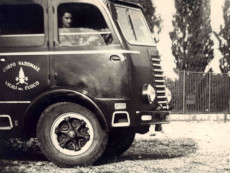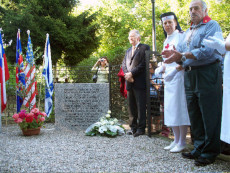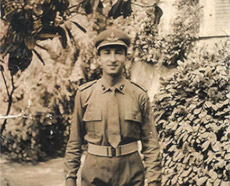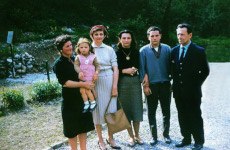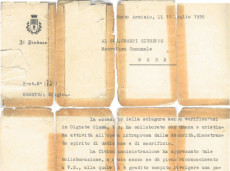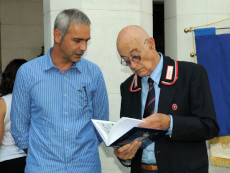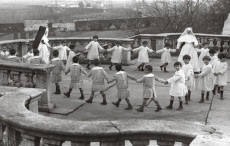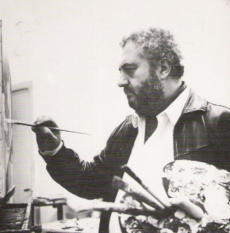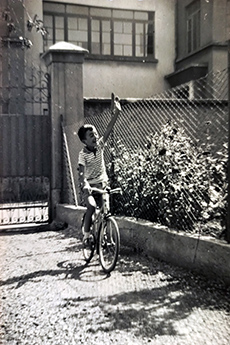
Witnesses of the plane crash
Antonio Monti
Antonio Monti (1938-2020), fireman from 1953 to 1973; on June 26, 1959 he was among the firemen of Busto Arsizio-Gallarate teams who rushed to Olgiate Olona. He remembered:
«June 26, 1959 afternoon, the following night and June 27 were awful for us belonging to the brigade rushed to the place of disaster: marshal Bianchi, Marco Geddo, Pasquale Moia, Giampiero Macchi, Boneschi, Bosio, Renzo Gussoni, Locati, Azimonti, Pozzi, Checchi; Mazzucchelli at the phone exchange and Natale Carnevali remained in the barracks. When we arrived in front of that scene under the storm we were aware of what we had to expect: we threw the foam for a short with the Fiat 42 [standard fire engine of that time with fifteen hundred liter tank], because we realized that there was no lives to save: it was useless to persecute the remains of corpses, some of which were out of the fuselage. (...) Together with the policemen we guarded the area in the following days too: no valuables were touched or removed from the crash site. Furthermore, that Super Constellation was named Evelyn: it was a habit among TWA pilots - almost all veterans of World War II - to give a name to the airplanes they flew, just as they did in war; and the name Evelyn was painted under the cockpit of the plane which crashed in Olgiate Olona. In my life and professional carrier I saw five plane crashes but I mainly remember that hell that often I thought about: the disaster of Olgiate Olona was the worst without doubt, maybe because it was the first I intervened into and for its seriousness anyway.
On June 27, 1959 morning one thing surprised me: before the beginning of the recovery of victims, the TWA staff who arrived to the crash site offered us spirits. Only after having put my hands in that hell I realized that thoughtful gesture. The awareness of what was experienced and done turned out two days later: personally I never forgot that memory, it came to mind several times for very long, in spite of the fact that I worked as a butcher and I was familiar with the pieces of meat».
2008 - Eyewitness Antonio Monti interviewed by Rete55 network
The name of L-1649A - N7313C Starliner
December 2012 - Jonathan Jon Hibbard Proctor (1942-2020), TWA historian, wrote us regarding the name of the Starliner L-1649A (reg. No. N7313C, msn 1015) that crashed in Olgiate Olona on June 26, 1959:
«Regarding the name on N7313C, TWA records indicate it was indeed assigned ‘Star of the Severn’, and confusion between that name and ‘Evelyn’ is understandable. However, there is considerable evidence that only the first eight Starliners actually wore the assigned names and the rest were either not so painted or the names were removed early on. All the photographs I have of later Starliners - and many were taken before 1959 - show no names on them. This suggests N7313C did not have a name on it at the time of the accident. Unfortunately I’ve never found a picture of it before the accident.
I’ve learned never to say never in such cases, and it is possible that the name was on that airplane at the time of the accident, but I doubt it. There is the possibility that the name may have been on some kind of plaque inside the passenger cabin, but I’ve not heard of such an arrangement.
The River Severn is the longest in the U.K. Apparently the plan to use rivers (for aircraft naming) gave way to naming the first 10 Starliners after US states; names of estuaries were assigned to the rest (and perhaps all at one time) but it is thought that none were applied to Starliners beyond N7310C. Why is anyone’s guess!»
A question arises: perhaps ‘Severn’ was misinterpreted as ‘Evelyn’ - due to damage to aircraft after the accident?
Enrico Biganzoli
Enrico Biganzoli (1937-2019), driver second lieutenant in service in Milan, on June 26, 1959, was driving in Olgiate Olona along the Milan-Varese highway right in the moment when the airplane crashed to the ground:
«I was 22 and I was in the army for a few days in Milan as a driver, second lieutenant in the vehicles repair workshop. On June 26, 1959, afternoon, having decided to go to my house in Jerago con Orago to take some clothes, I was driving northwards along the Milan-Varese highway with my Fiat 600 while a strong storm was raging. After Castellanza, while I could already see from afar the first of the bridges on the highway in the territory of Olgiate Olona, I first heard a loud bang that was not like the noise of a thunder, then out of the corner of my eye I saw something huge falling down in flames at my right. I stopped my car on the roadside - it was allowed at the time - and under the storm, with my brand new uniform, I went down the slope and I entered the part of the forest near the highway that was not on fire. I reached the crash site and I saw the fuselage of the airplane - partially entire - crushed to the ground; I stopped to observe the sheet metals from which a column of black smoke rose; I could not distinguish the wreckage of the airplane from the remains on the passengers; there was a strong smell of fuel: what I saw was turning my stomach. A few minutes later I heard some female voices beyond the point where I stood, amid the smoke; I shouted at these people to stay away and that it was dangerous. A quarter hour later the Firemen arrived onsite and I spoke to an officer; I had to leave the place, because I still had to go home and then go back to the barrack in Milan later that evening. While I was walking back to the car I noticed other wreckages of the plane fallen to the ground away from the cockpit. Later, when I was driving along the highway in the opposite direction - going from Jerago con Orago to Milan - I was rather in a hurry and I only saw a row of cars parked on the roadside on the opposite roadway. This tragedy then fell into oblivion for years: but every time I passed on the highway by Olgiate Olona I always saw that shattered cockpit before my eyes».
Enrica Castiglioni
Enrica Castiglioni (1928-2020) on June 26, 1959, was among the Red Cross nurses who rushed to Olgiate Olona:
«I remember very well the plane crash because it was something really frightening, but not only because I was already in the Red Cross but for what actually happened, for the risk and everything else. It was a terrible event because the airplanes were few at that time and this kind of news made much buzz. The image that most impressed me was the one of the St. John the Baptist church in Busto Arsizio with all the coffins lined up. Because our Monsignor Giovanni Galimberti engaged himself so much and had offered the church to accommodate all the coffins: and this depressing sight with all the relatives coming here from all parts of Lombardy was the thing that really impressed me. Red Cross contribution was pretty useful, because the inspector was not there: she was away, she had gone to visit the house in Fiesole where sometimes we could spend some days. A deputy inspector - Prof. Eufemia Rossi, now already dead too - substituded the inspector and made a brilliant service, she instructed the older nurses, those who could do more things. But the Red Cross did not do much as intervention on site: the task was to receive relatives and help those who were feeling bad. I had hurt my hand while skiing and I had my hand in plaster until a short time before, so they put me on the phone; I was making phone calls with my left hand to collect all the Red Cross nurses that could be there: they all came and gave their help. There was so much despair among the relatives because of the fact itself and because of some rumors of pilots of competing airlines who said: if the plane had waited five minutes, the lightning would not hit it. But these were only rumours, let’s say, taken and collected as these were».
2008 - Eyewitness Enrica Castiglioni interviewed by Rete55 network
Davide Barbieri
Davide Barbieri (1909-1987) was in his house at Cascina Agnese at the moment of the crash:
«I was in my house with my wife when I heard a roar and I saw the glare of lightning at the same time. My wife crossed herself. Another roar was heard few moments later. Few minutes passed. The light went out. In that same moment I heard my son running home and screaming terrified: “Dad, dad, an airplane is falling in flames”. His eyes were no longer colored. I run outside and I saw the airplane falling down headed towards our house. During its fall the airplane was making a noise similar to a turbine, as the wind noise when there is a storm. I saw it get closer and I realized that if we wouldn’t ran away immediately then we would all die. I then took my wife by her arm, I screamed to Adele and Ugo to come with me on the other side of the house. When we went outside I saw the airplane at a distance of not more than fifty meters. It seemed to me that it was falling right on us. We took refuge behind the wall opposite the farmhouse just in time, then we heard another huge roar and the house shooked. My wife was screaming, Ugo told me sobbing: “Dad, dad, I don’t want to die”. High flames were raising from the wreckage of the airplane. There was a tremendous heat all around. We all walked away without thinking to take anything with us. A moment of silence followed the roar. No wail was coming from the wreckage: none was asking for help. They were all dead. Then the crackling of the flames began. My neighbour Tullio Adobati immediately took his motorbike and ran to call the fire brigade. Along the way he met the policemen of Castellanza headed by Marshal Pietro Barello who saw the airplane exploding in flight and who were rushing to our farm. I don’t remember anything else. Many people began to come. There was a lot of confusion all around. Everyone was asking me something and I really didn’t know what to reply to all those questions».
(taken from Il Messaggero of Saturday June 27, 1959)
Ugo Barbieri
At the time of the plane crash Ugo Barbieri was 15 year old and lived with his family right at Cascina Agnese. He was standing in his farmyard when the Super Constellation crashed on June 26, 1959. Terrified by the scene he watched, he told the reporters rushed to the place of the accident:
«The airplane seemed headed right toward me, it was coming down in flames and it seemed to me it was continuously being hit by lightning. But probably it was the wreckage burning».
Olga Adobati
Olga Adobati (1918-2011) was in her house at Cascina Agnese at the moment of the crash. She told the reporters rushed to the place of the disaster:
«It was around 5.30 p.m. The rain was coming down in cataracts. It seemed the end of the world. The sky was black and the flashes of lightning chased continuously through the darkness. My two little girls were glued to the window, with their noses flattened against the glass, watching the lightning and the streaming rain. Suddenly the eldest, Maria, aged 10, dashed toward me screaming “Mamma, there’s an aeroplane falling on us”. She was terrified. I flung open the window and saw a great column of smoke and a mass of flames, which seemed to be advancing on us. I shouted to everyone to fling themselves on the ground and get under tables, and an instant later there was a tremendous explosion. Immediately after the explosion there was a great silence. We dashed out in panic, and the first thing that struck me was the sight of dolls lying in that mud and rain. One doll seemed at first sight to be a child. In the pilots’ cabin, the pilot was still gripping the control column».
(taken from Sydney Morning Herald of Sunday June 28, 1959)
Costanzo Colombo
Costanzo Colombo (1926-2011) on June 26, 1959 was going back to firm “Castellanza & Borri” by truck and under the violent storm he was attracted and intrigued by the looks of people: all the eyes were looking to the sky. Then in a very few moments he saw the Super Constellation’s rudders falling down in front of him against a wall, slashing his way and forcing him to stop. Once he became aware of the terrible disaster he was among the first to rush to the crash site.
He remembered with commotion:
«I ran away in despair: pieces of persons were spread all around, their heads were among the trees».
2008 - Eyewitness Costanzo Colombo interviewed by Rete55 network
Giuseppe Cerana
Giuseppe Cerana (1932-2020) on June 27, 1959, was recruited to weld the zinc of the sixty-nine caskets containing the remains of the victims, although it was not a welder. He told:
«One of the welders recruited to close the caskets was taken ill and for this reason he was replaced by myself. My job was to put the muriatic acid on zinc which became cooked and allowed the welding of caskets. We managed in some way: there was no test with candle to do to see if the caskets had losses since there was just enough time to close the caskets and load them in groups of four on the truck that brought them in the church of Busto Arsizio. The bodies of the victims were deformed: in most of them there was only the trunk and some others were ripped».
2008 - Eyewitness Giuseppe Cerana interviewed by Rete55 network
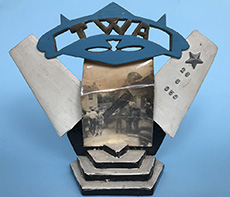
09/07/2021 - One year ago (on July 6, 2020) Giuseppe Mario Cerana - eye-witness of the plane crash and volunteer in the welding of coffins - joined the seventy immortal lives. While tidying up his personal belongings, Cerana’s relatives have found two precious testimonies he had kept: the negative of a photograph showing the rudder of the unfortunate TWA aircraft crashed on the boundary wall of a textile factory in Olgiate Olona, and a simple handwork with the same photograph embedded built by Cerana in memory of those indelible days. By thanking Cerana’s family, the staff of the commemorative events of June 26, 1959, once more, fondly remembers Giuseppe Mario.
Giovanni Rossini
Busto Arsizio mayor Giovanni Rossini (1903-1986) was among the first to rush to the site of the disaster:
«I was inside Castellanza & Borri factory when, at a certain point, there was a tremendous rumble and simultaneously I saw a lightning’s glow. The second rumble was heard few moments later. I realized that something serious had happened because a few moments before we had perceived the roar of an airplane’s engines above us, and these were immediately silenced after the first rumble. I went outside and I saw right above my head the airplane catching fire and which began to fall down. Red and yellow flames were arising from the middle part of the airplane. Soon after, when it was falling vortically having covered half of its precipitous descent, I saw it disintegrating: the airplane lost a wing first, then - while it was falling - it seemed to break up into fragments while the fuselage was burning with high flames. The airplane didn’t fall perpendicularly but it crossed the axis of the Olona river and crashed beyond it. The airplane’s fall lasted for six-seven seconds. I picked up my car and I rushed to the place of fall recognizable by a high column of black smoke. On the overpass along the road from Marnate to Olgiate Olona I ran into a pylon of the high voltage line that had been cut by one of the engines which had detached from the wings. The wires had caught fire and were emitting sparks intensely. I went back and I was finally able to reach Cascina Agnese. The airplane’s wreckage had crashed a few meters from the farmhouse right on the shoulder of the Olona valley, sheet metals were burning like vellum paper. No one could have survived. Together with Firemen and Carabinieri of Olgiate Olona and Castellanza - who arrived almost immediately on the site of crash - we explored the whole area around. The corpse of a man was lying among the branches of a tree. The Carabinieri recovered and laid him on the ground covering him pitifully with a blanket».
(taken from Il Messaggero of Saturday June 27, 1959)
Daniela Crespi
Daniela Crespi, daughter of Giuseppe Crespi the gravedigger of Municipality of Busto Arsizio who took part in the recovery of victims of the plane crash, told:
«In 1959 I was just one year old then I have no memory, except the stories of my mother on that unfortunate fact. My father, Giuseppe Crespi, was the gravedigger of Municipality of Busto Arsizio at that time; he took part in the recovery of the victims but never told us the horrifying scenes he saw, except the victim not yet born who passed from the womb to death. My father received a praise by Busto Arsizio mayor Giovanni Rossini for the work done; he kept it in his wallet until the day of his death in 1975: I kept it proudly in my wallet too for a bit of years, unfortunately reducing it quite badly!»
Pier Giorgio Fieno
Pier Giorgio Fieno (1938-2018), as Carabinieri corporal on June 29, 1959, he made an Honor service beside the “representing casket” (numbered “1”) during the funerals in Busto Arsizio. He remembered:
«From my service position I could observe the relatives and the crowd waiting for the ceremony and during the same, as well as during the short procession outside. I can’t really remember faces and expressions but it is well rooted in me the sense of dismay, pity, sorrow which permeated the church and the square. Due to my job I was accustomed to the pain of people affected by a death, but in that case the pain was involving so many people to be palpable. So much pain but so much dignity and participation; no applauses, no camera flashes except those of few professional photographers; so many tears, so many prayers and much respect. I’m not ashamed of having had tears in my eyes several times, because yes I was an officer of Carabinieri but I was also an ordinary 20 year-old young man».
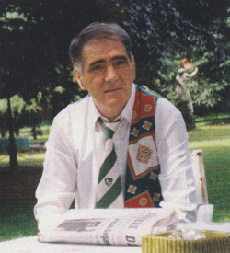
Gualtiero Conti
Gualtiero Conti
Gualtiero Conti (1932-2015), journalist, awarded with gold medal for fifty years of journalistic career in 2015, dean of journalists of his hometown Legnano, Italy, remembered:
«I got off the taxi on the county road, near Marnate in the province of Varese, it was about 18:30. It was raining hard, the sky was black and I ventured in the vallaccia, in woods of acacias full of water. I reached the flat ground, I saw the lights of four photoelectric lamps pointed at the wreckage of the shimmering pearl-gray airplane. The tail rudder was detached from a large part of the fuselage. While I was moving among the mud of the plain, I stumbled into the body of a young woman, and a few meters further on, in the body of a man. They had been thrown out of the airplane, an USA made TWA plane which took off from Milan Malpensa Airport, with an American final destination; probably they were husband and wife. I proceeded in the glade and approached the lights that were illuminating the wreckage of the aircraft. I thought that the plane had been hit by lightning right on the tail, and later I was confirmed by two officials from Malpensa who arrived on the scene. In the meantime a people of onlookers had gathered around the remains and policemen and Carabinieri struggled to keep them away. It had stopped raining, I heard the desperate voice of a woman who approached by screaming and crying: “Rose, Rose, my daughter, she had returned to Italy to celebrate her first year of marriage. She was pregnant...”. A tragic fate took her away instead. Meanwhile, several colleagues of some newspapers had arrived on site: Egisto Corradi of Corriere della sera, Onorato Orsini of La notte who was a movie critic, and lastly - among those that I knew - Francesco Rosso of La stampa of Turin. I was a 27-year-old reporter gathering news on behalf of Il popolo of Milan. I had been among the first reporters arrived on the site of the plane crash, on that late afternoon on June 26, 1959. Soon the archbishop of Milan came, he was Giovanni Battista Montini from Brescia, Italy, who was to become Pope Paul VI a few years later. The archbishop went on the wreckage of the airplane and gave the absolution to the many corpses laying, mostly seated in fuselage. Then the cardinal embraced and blessed the weeping woman. We entered the farmhouse touched by the crashed plane. “It was raining hard – a girl of about 16 told us – I had approached the door to close it, and in the dim light (the daylight saving time was not in use yet and it was just past 17:30) I saw the lightning hitting the aircraft and illuminating the sky and then the plane falling in the garden of the house, a few meters from us. My father had just asked me to close the door because the rain was pouring down sideways... We heard a loud crash and the ground trembled as if there had been an earthquake. We were lucky. We could be dead! Maybe it was a miracle for us”. In the meantime I had the problem of returning to the newspaper office for the publication of the text, and Egisto Corradi - while the photographers continued to take pictures - kindly gave me a lift and took me back to the office in Milan. Modern technologies did not exist at that time. The day after, Saturday, a mocking sun was shining on the white caskets lined up on the yard of farmhouse Agnese: in some caskets only bone remains that were impossible to identify. I could smell again the sickening smell of the dead bodies, I relived the disaster, I was thinking about my beige moccasins and my waterproof jacket that I had to throw away... Today, more than fifty years after, my nose has not forgotten yet».
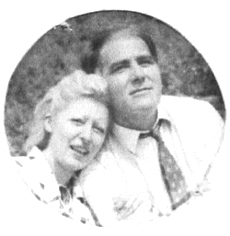
Silvana Scanagatta and Gualtiero Conti
Silvana Scanagatta
Silvana Scanagatta, writer, painter and wife of Gualtiero Conti remembered the plane crash of June 26, 1959, in her tale Una bambina ricorda (trans. a little girl’s memory):
«I was 5 and I was playing with my sister Marinella in our home garden in Castellanza. The sky was pale and a storm was coming. My mother was looking out the window and - troubled by thunder and lightning - she urged us to get into the house. By tradition, she burned some leaves of blessed olive tree with a prayer. At that time it was likely that a summer storm could bring hail, me and my sister prepared a lemon granita in a large bowl with those iced balls. I was looking up, and I remember that I was suddenly scared by a booming thunder and lightning that dazzled the sky. The first drops of rain fell down, a lightning struck an airplane that from my view had just passed the eaves of the roof of the house. With my eyes staring at that scene, I distinctly saw the silver aircraft breaking into two parts and the tail falling down from the sky with a crackling noise, accompanied by two fireballs falling at right angles - one above the broken tail of the airplane and the other in the middle of the same tail – that were extinguishing by leaving a thin dark trail that dissolved in the air within a few moments. The falling fuselage reflected a silver light against a sky that had become dark purple. My mother rushed out and took us home. I asked her: “Mum, mum, and now? Why?”. She simply replied that something bad must have happened to an airplane. In the meantime, some women in the neighborhood were at the window, some others were at the door, and they asked excited questions. This is what I remember of that tragedy, despite of my young age. Many years after I got married with Gualtiero Conti. He was passionate about aviation, like everyone else in the family. One day I discovered that he too was an eyewitness of the plane crash on that fateful June 26, 1959, as a reporter of Il popolo newspaper of Milan, and that he preserved the memory of the disaster intact».
Loris Francesco Capovilla
Loris Francesco Capovilla (1915-2016), late segretary of pope Giovanni XXIII whose commotion on the occasion of the plane crash he recalled, then archbishop and cardinal in 2014 (Sotto il Monte Giovanni XXIII, Italy):
«Dear Sir, I remember the mournful event of Olgiate Olona, June 26, 1959. Very painful impression even in the Vatican. Holy Mass celebrated by the Pope. All was documented in the Secretary of State. You could refer to the daily and weekly newspapers of that time. Cordiality, greetings, long life».
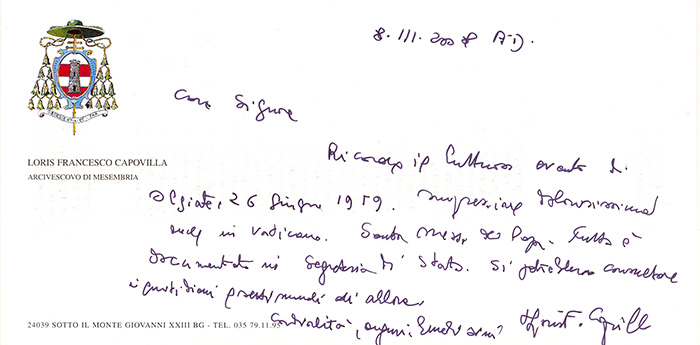
Sisters of Charity of St. Joan Antida Toureth
On June 26, 1959 the burning fuselage of the Super Constellation crashed few dozens meters away from the buildings of the Opera prevenzione antitubercolare infantile (Opai) (foundation for childhood tuberculosis prevention) which housed hundreds of children. Sisters of Charity of St. Joan Antida Toureth working inside the buildings wrote in the Opai’s diary on June 26, 1959:
«June 26, 1959. An airplane crashed at 17.35 in the direction of the new Pavilion, 5 meters away from the Preventorium. As soon as the crash was heard, all the sisters were in the sectors to be close to the children. Once they understood the serious danger they kept calm not to impress their beloved children: these ones didn’t realize indeed and they confused the loud noises of the burning airplane with the noise of the thunderstorm. It was truly a grace of the Lord and the Heavenly Mother that nothing happened in Preventorium, as several pieces of metal dropped in different places (...)».
Guests of Opai (foundation for child tuberculosis prevention)
The plane crash of June 26, 1959, did not cause damages to the town and the people of Olgiate Olona and firstly to the buildings of Opai (foundation for child tuberculosis prevention) – located a few dozen meters from the place where the fuselage crashed – where hundreds of children were housed, cared for by the nuns, the attendants and the other staff. Some of them today still remember well the disaster according to the testimony contained in the book Opai, io c’ero... Voci e volti della Casa dei bambini di Olgiate Olona, presented in Olgiate Olona on October 26, 2014, and written by native Enrica Mariateresa Ferrazzi who kindly allowed us to publish a few excerpts of the testimony.
Adondi Elena (child guest in Opai in 1958-1960):
«On June 26, 1959, me and my sister Serenella were in a classroom, we were learning a poem to be recited at a wedding that would have been celebrated the day after in the parish church of Olgiate Olona. Since I was suggesting some verses to my sister, I was put in punishment in front of the window: it was raining heavily and thundering. Suddenly there was a deafening roar, I still can hear it: an airplane was falling down. In front of that window I attended a tragedy that – as I learned years later – caused the death of seventy people. I warned the nun of what I saw: “It’s falling! The airplane is falling!”; “Shut up!” she replied peremptorily. I said again: “But it’s falling down!!!”; and then the crash happened: all lasted a few minutes. I remember there was a big turmoil: all the children were taken into the church to pray, and in the evening we looked through the window of the dormitory a lot of people running down the street».
Adondi Serenella (child guest in Opai in 1958-1960):
«I remember a sad episode: we were in the classroom reciting a poem when a strong storm raged beyond the windows; we heard a roar of engines and a tremendous bang. Only later we were told that an airplane with passengers onboard had crashed near the orchard. I learned that it claimed the lives of seventy people only some years later».
Andreani Oriana (child guest in Opai in 1958-1960):
«A memory still vivid in my mind is that a plane fell right in Olgiate Olona during the years I have been staying in: it was one of the first accidents of that kind and it shocked all the community. The news of this fact reached us kids and our imagination was really impressed».
Bertelli Ida (worker in Opai in 1957-1962):
«I remember the afternoon of June 26, 1959, when we heard a terrible noise coming from the sky: we looked out of a window and we saw a ball of fire in the sky falling down quickly; it was an airplane and thankfully it did not cause casualties in the Preventorium, even if a piece of wing and fuselage fell in the park of Opai. Luckily, because of the bad weather, there were no children playing in the park otherwise it would have been a massacre».
Corti Franca (attendant in Opai in 1958-1961):
«I remember that on June 26, 1959, a terrible accident happened right near the nice park of the Preventorium: a plane crashed during a violent storm. I was resting and so, despite the bad weather, I went out to go to see what had happened. The scene was truly awful: I cannot forget those flames and that smell. The police arrived shortly after, they fenced off the area and made us turn away; later I learned that all the people onboard had perished in the crash».
De Lorenzo Anna (child guest in Opai):
«I arrived to the Opai on August 16, 1958, there I attended the primary school. When an airplane crashed in June 1959, it was a bad day full of emotions. Me and my fellows were watching TV when we were told about the tragedy. For some days we were not allowed to go out in the park, since it was full of small debris of the aircraft. Some reporters arrived to make some interviews».
Fontana Luigi (child guest in Opai in 1958-1960):
«I remember that it was late in the afternoon and a thunderstorm was raging; we were sitting watching television, it was high on a trestle; we heard a very strong roar and a strange light came in through the obscured windows. After that there was an endless sound of sirens, noises were coming from over the wall: we had the feeling that something terrible had happened near the institute. The day after, while we were in the garden we gathered a lot of metal debris. Later we were told that a TWA airliner crashed not far from our institute after being hit by a lightning. Roumors said that the plane had crashed violently and that it was a terrible sight: a pile of charred bodies, unrecognizable and impossible to be separated one from each other».
Giove Franco (child guest in Opai in 1959-1960):
«From March 1959 to September 1960, I was a guest in the Opai preventorium of Olgiate Olona. I was thirteen. Perhaps the strongest memory of the period I spent in Olgiate is related to June 26, 1959. We were playing in the halls of the pavilion when all of a sudden the nuns gathered us, they took us to the theater room and then we began to pray the Rosary. This was unusual, because the time of the Rosary was later. We could see that the attitude of the nuns was of concern and we did not realize why. A plane crash had occurred over the sky of Olgiate Olona. After filling up with fuel and taking off from Malpensa airport, a TWA Super Constellation was struck by lightning during a violent storm and crashed to the ground missing the Opai complex for a few dozens of meters. Bits of a wing, of the fuselage and several fragments of metal fell all around us in the park of the Institute. We later learned that all the passengers on the plane had died, about seventy people».
Magagnini Nella (worker in Opai):
«I remember a day in June 1959: I was doing my laundry while a violent storm was raging: suddenly I heard a terrible noise; I ran out together with other girls and we realized that a plane was falling down. It was a really tragic scene; luckily the buildings of the Opai were not hit, but the plane crashed not far from the Preventorium: the tragedy could have been even greater».
Mattielli Claudio Roberto (child guest in Opai):
«It happened that an airplane crashed, it was probably a small 2-engine aircraft. I remember the pieces scattered here and there in the football field including the wings and the turbine. So much clamor and curiosity! I remember an excerpt from a newspaper».
Mussati Massimo (child guest in Opai in 1957-1959):
«My most vivid memory is that famous day of the plane crash. It was raining and we children were playing; suddenly a loud noise - different from the thunders of the ongoing storm – made us all run to the windows to realize what was happening: I remember a brown smoke that rose into the sky. A nun quieted us by telling that that smoke was the lightning. I remember that we were not allowed to go out for a long time».
Ortis Maria Cesarina (child guest in Opai):
«One of the most vivid memories in my mind is that of the plane crash of 1959. There was a very bad storm. I remember that we heard a loud noise. A servant came shortly after, she was so terrified by what she saw that she could not speak. She murmured disconnected phrases: «The sun fell down!». Actually an airplane had crashed. It was really a miracle that no one of the children guest in Opai died in the disaster. A lot of debris of the aircraft fell in the park: some seats too. A seat was fallen even on the terrace! The following days the nuns didn’t allow us to go out in the park because the surveys were underway. I remember that some coffins were placed in a burial chamber improvised on the ground floor of the infective desease pavilion».
Scola Giancarlo (child guest in Opai):
«Among my recurring thoughts there was one which prevailed: the mystery of the plane crashed that could put my melancholy thoughts in second place in that moment of great intimacy. Sure, reciting prayers did not encourage any funny thoughts. It was rumored among us boys that an airplane had fallen in the bottom of the pinewood during the last war, on the border of the boundary walls in that area that we touched on several times but that we never reached anyway. Did it really happen? Was it a legend? The fact is that we were so much courious and it would have been a dream for us to reach and reconnoiter that place, perhaps in order to find some signs of the fact happened or maybe some objects belonging to the airplane. The mystery was never revealed».
Sonzini Angelo (child guest in Opai):
«Concerning the plane crash of June 26, 1959, I remember that there was a strong thunderstorm that evening: they sent us in the salon and I remember the sirens of ambulances; the day after in the park some people were collecting the debris of the airplane».
Vernizzi Fabrizio (in Opai in 1958-1960):
«I remember the tremendous bang that we heard that afternoon in summer of 1959 when a plane crashed right near the park of Opai: we were watching television at that moment».
testimony taken from: FERRAZZI Enrica Mariateresa, Opai, io c’ero... Voci e volti della Casa dei bambini di Olgiate Olona, Olgiate Olona, 2014
- website www.opai.it
Ernesto Milani
Some TWA employees operating at Milan-Malpensa Airport rushed to the site of the plane crash. Ernesto Milani was among them. He wrote on the website portal.lombardinelmondo.org:
«My interviews with TWA employees who took part in the rescue operations confirmed the shock which followed the accident. A flight was still an event at that time and TWA was a leader in transatlantic air transport. The ground crew had a very close relationship with the passengers and especially with the aircraft crews. It was so terrible for them to go to Olgiate Olona and take part in the recovery of the bodies of both passengers and crew members hailed a few minutes before. The tension eased only with the arrival from Paris of the TWA Vice President and his emergency team which took the direction of the recovery operations of the wreckage and the relating investigation. The accident was always remembered by the TWA employees at Malpensa often accused of being too meticulous in terms of safety of passengers and aircraft maintenance».
Giacinto Ferrazzi
Giacinto Ferrazzi (1930-2021) rushed to the site of the plane crash together with other TWA employees operating at Milan-Malpensa Airport:
«When the disaster happened I lived very close to Malpensa Airport and I rushed to the site of the plane crash right after having heard the news. When I arrived on site I was not allowed to enter the area. At the time I was a TWA employee in Malpensa; we began to prepare some wooden cases, packing cases, etc., to collect and ship all the things that were recovered from the remains of the fuselage. I couldn’t get a copy of “La prealpina” newspaper of that day, but four years ago I found this insert in the newspaper and I cropped the page. That tragedy is still inside myself, it was something impressive despite having seen it from afar. I remember those trees that were full of human remains, it was really a tragedy».
2008 - Eyewitness Giacinto Ferrazzi interviewed by Rete55 network
Andrea Vaccaro
Artist Andrea Vaccaro (1939-2019) saw the parts of the TWA Super Constellation falling down. The following is his testimony written on January 20, 2008, in his blog at pittoreandreavaccaro.blogspot.it:
«I was an eyewitness at the crash of the USA bound airplane which took off from Malpensa airport with one hundred passengers on board [more precisely, the people on board were seventy and the plane was headed to Paris, ed. note]. Scientist Enrico Fermi’s sister was among the victims of the crash. In the middle of June 1958, a lightning hit the airplane at approximately 3 o’clock in the afternoon [the disaster happened at 5.33 p.m. on June 26, 1959, ed. note]. The engine turned off and the flames wrapped all the plane from the nose to the tail. The silent flight continued at least for a few minutes (ten minutes maybe). Then an engine broke away from the right wing and fell in the territory of Marnate. The plane flew a few minutes again in the sky. Then the nose tilted toward the ground and the plane screwed while falling down. It crashed to the ground in the Olona Valley, few kilometers west of Marnate. The crash caused an explosion and a huge column of smoke rised into the sky. I rushed with my bicycle from Legnano to the site of the disaster - a few kilometers far - but I only managed to see the engine which had broken away and crashed before the airplane, it was stuck in a field along the motorway. Later I heard the news of the death of all passengers. Why is there no news in the web? It’s possible that there are some mistakes in my story, considering that nearly fifty years have passed. It’s not easy to remember all the details after fifty years».
Leo Granata
Leo Granata saw the pieces of the TWA Super Constellation falling down while he was going back home, his house being located in Olgiate Olona a few hundred meters from the point where the aircraft fuselage crashed:
«It was about 17.30 of June 26, 1959: I was coming from Castellanza by bike and I was in a hurry, because a strong storm seemed to arrive in a short. I had just arrived at the gate of my house, in via Cesare Battisti street, and it began to rain. While I was quickly laying my bike under the balcony, I heard for a few seconds a loud hissing that vaguely remembered the sudden braking of a train; I instinctively looked up at the sky and saw something that I did not understand what it was at the moment, something that was dismembering. It seemed to me that three pieces were falling down, but in fact they were more. The first piece was quite voluminous and was falling to the right of my position; the second one was the biggest and burst into flames in the meantime, it seemed to fall down just toward me as did the third piece. It took me a few seconds to realize what was going on: an airplane was falling down. The first piece was a wing with an engine, it fell in the hamlet of Marnate near Galli’s sawmill; the second one - the one that seemed to fall down on me - was the burning fuselage, it crashed about 1000-1300 ft beyond the highway passing 160 ft far from my house; the third one was the rudder and I saw it passing over me, it was flying gently, then it missed the turret of a building and finally leaned on the walls of Moro’s workshop about 500 ft far from the point where I was. While I was watching the rudder coming down, I saw an engine of the airplane falling in left field located at the end of the descent of via Battisti street, it crashed to the ground forming a crater a few feet from the highway, after having missed the roof of De Dionigi’s house. I immediately ran toward the point where the fuselage had crashed. While I was moving along via San Genesio street I was convinced to be among the first to arrive on site, but I have to admit that I was wrong: a large group of people had already gathered at the crossroads of via San Genesio and via Luigi Tovo streets, about 300 ft from the site of the disaster; someone was urging to get away for an impending danger of explosion. I went back home. Toward evening I went back again on the site and I managed to get a few dozen meters from the wreckage of the fuselage. There were so many people that the policemen were trying to stave off with difficulty».
Marco Pisani
Marco Pisani, born in 1950, saw the TWA Super Constellation falling down in flames while he was at home:
«When I happen to pass in front of the monument that commemorates the tragedy of June 26, 1959, I stop for a prayer and my mind opens up to memories which - even if distant - are always clear and imprinted in my memory. That Friday afternoon I was in my house located in via Vittorio Veneto street doing my holiday homework; my parents were at work and I was entrusted to my grandmother Teresa, assiduous and always apprehensive in looking after me. There was a violent storm and a strong wind; my grandmother - as usual during storms - went out and burned an olive branch to ward off bad weather, when she suddenly let out a cry; I went out too and I saw a burning airplane in the sky loosing its pieces; the emotion and fear were strong for a boy not yet 9 years old: my house was about 300 meters from the place where the fuselage crashed. At a certain point we went towards the garden and I saw something that looks like pieces of cardboard whirling in the air; one of these passed a few meters from me and cut the tomato supports cleanly: they were sheet metals of the airplane that had been dispersed throughout the village. Following my father’s report, the Carabinieri came a few days later to collect the sheet metal that had fallen in the garden; another bigger one had fallen in the schoolyard which was located in front of my house».
Giuseppe Pinuccio Gianduia
The memories and emotions of the plane crash of June 26, 1959, told by grandfather Giuseppe Pinuccio Gianduia to his granddaughters:
«Dearest Alessia and Valentina, on June 26th, 1959... while a strong storm is underway, I am sitting in the corridor of my house, sheltered from the rain, in front of the door of what for many years had been Teresa and Stefano’s home, my mother’s cousins. Mother Lucia and aunt Vicenzina - my mother’s sister - are sheltered in front of the entrance to our kitchen. They are reciting the Holy Rosary while burning the Easter olive branch to ask the Madonna for protection against lightning, especially so as not the harvest is not damaged. I recently turned eleven. I passed with good grades at the end of fifth grade and was enrolled in the middle school of Rotondi College of Gorla Minore. I’m not obeying my mother because I would like to go to watch television to my cousin Giampiero who lives in the nearby courtyard, and who has had the TV for a short time. I am allowed to open the house, to turn on the television, to watch the arrival of the stage of the Tour, the Tour de France, because when Giampiero returns home I have to tell him who won, who is first in the ranking and how the stage went! But it’s raining and there’s a storm: if the television breaks down there’s serious
trouble! (...)».
Colpo di fulmine (ligthning strike), by Giuseppe Pinuccio Gianduia
Annamaria Guidi
The memory of the plane crash of June 26, 1959, in the story of Annamaria Guidi:
«A long time had passed since that terrible tragedy when my sister - almost six years older than me - told me about it for the first time. The collective memory of that fatal event remained so vivid over the years that it led the community to erect a monument in memory of the victims.
So on the day it was inaugurated, in houses, in bars, in clubs, everywhere there was even more talk about that event that had upset the ordinary life of the town, everyone remembering where they were or what they were doing on that tragic afternoon of June 1959. Therefore, me too, who at the time of the crash was a child of just a few months, I wanted to know about that story (...)».
R.P.
R.P. (he preferred to stay anonymous) was living near Livraga in 1959, he remembered the four victims from Livraga:
«I owe my life to my dad. My family had a farm near Lodi and I wanted to follow this group of friends on that vacation in Paris. My father didn’t let me go because we had so much wheat to be cut and it was not insured against hail. I obeyed smugly. Then in the evening of June 26 I heard the news: air disaster of the TWA Super Constellation, and so on...: I had no words, I kissed my dad. I kept this secret for half a century and I’ve never told anyone. Few years after the tragedy then I came to work and to live in Marnate: it was by chance and for work reasons. But I often pass near the memorial of the plane crash: sometimes I park my car and stop for a small greeting».
2008 - Witness R.P. interviewed by Rete55 network
Norberto Iacopino
Norberto Iacopino remembered the tales of his father, carabiniere in service in Busto Arsizio in the days of the tragedy:
«It was a hellish scene that was impressed in the people and the rescuers. Among other things my father was in service in Busto Arsizio at the time and was with the captain when they saw the plane falling down; then they headed immediately to the crash site where they found some colleagues of Castellanza already in place; soon after the firemen teams arrived. He never told me the most scabrous details, but arriving in a wooded area under a flood and seeing the remains of a plane with so many poor mangled corpses among flames and columns of smoke is a vision that leaves its mark, even to those used to these scenes and which saw the atrocities of the war. The tales about the difficulty to avoid that someone tried to take a few pieces as a souvenir have come to my mind; in fact my father contacted personally the Count Agusta to have the availability of a helicopter that would have allowed quickly to limit the area where the pieces of the airplane had fallen».
Francesco Enrico Speroni
Francesco Enrico Speroni, after having heard the noise of the plane, looked out the window of his house and saw the lightning striking the aircraft:
«I remember the plane crash of Olgiate Olona very well: I was 12 and I was already an aviation enthusiast. As soon as I heard the noise of the airplane I looked out the window of my house and I saw that airplane; I saw precisely the lightning that struck it, I heard a bang then the plane broke into three pieces. I remember that I called my mom and I said: “Look, an airplane crashed”. My mother said: “It’s only a child, forget it”. Instead, since at that time we were living in Corso Italia street in Busto Arsizio and the barracks of the firemen was located in the near via Castelfidardo street, then the fire brigade and ambulances passed in front of my house; then all the noise of the sirens followed. I realized that this huge tragedy had really happened».
2008 - Eyewitness Francesco Enrico Speroni interviewed by Rete55 network
